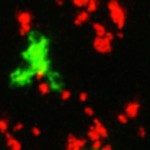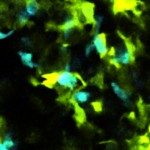Lien vers Pubmed [PMID] – 24556401
Curr. Opin. Immunol. 2014 Feb;26:56-62
A decade ago the first movies depicting T cell behavior in vivo with the help of two-photon microscopy were generated. These initial experiments revealed that T cells migrate rapidly and randomly in secondary lymphoid organs at steady state and profoundly alter their behavior during antigen recognition, establishing both transient and stable contacts with antigen-presenting cells (APCs). Since then, in vivo imaging has continuously improved our understanding of T cell activation. In particular, recent studies uncovered how T cells may be guided in their search for the best APCs. Additionally, the development of more sophisticated fluorescent tools has permitted not only to visualize T cell-APC contacts but also to probe their functional impact on T cell activation. These recent progresses are providing new insights into how T cells sense antigen, collect activation signals during distinct types of interaction and integrate information over successive encounters.


